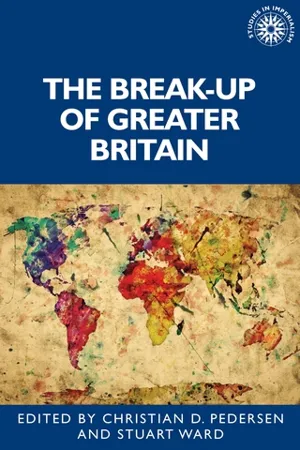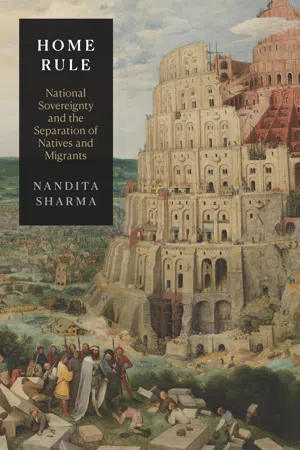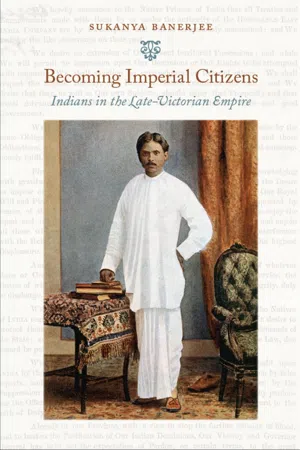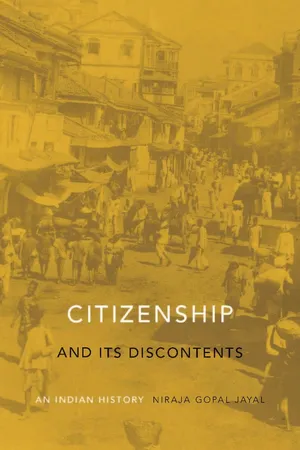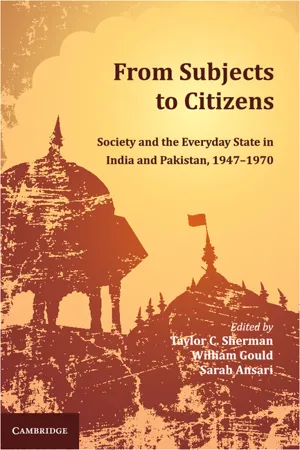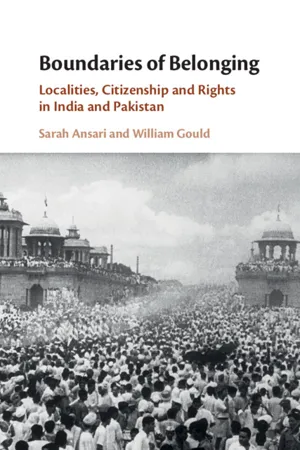History
Indian Citizenship Act of 1924
The Indian Citizenship Act of 1924 granted citizenship to all Native Americans born in the United States. This was a significant step in recognizing the rights of Native Americans and their inclusion as citizens of the country. The Act aimed to address the long-standing discrimination and lack of citizenship rights for Native Americans.
Written by Perlego with AI-assistance
Related key terms
1 of 5
7 Key excerpts on "Indian Citizenship Act of 1924"
- eBook - ePub
- Stuart Ward, Christian Pedersen, Stuart Ward, Christian D. Pedersen, Andrew S. Thompson(Authors)
- 2021(Publication Date)
- Manchester University Press(Publisher)
Where scholars have dealt with the provisions of the 1955 Act, this is almost always in comparison with the later amendments made in the context of ‘illegal immigrants’ in the 1980s. 23 Anupama Roy recognises the period between 1950 (when the constitutional provisions regarding citizenship came into effect) and 1955, when the Citizenship Act was adopted, as a ‘liminal space’ creating ‘awkward’, ‘transitional’ and ‘aspiring’ citizens, however, she views this solely from the lens of Partition and movement across the India–Pakistan borders. 24 Moreover, she does not ask why it was that such a liminal space was created or why the Indian Citizenship Act took so long to come into effect. As I will show, this delay was very much due to the struggle to disentangle identities shaped by empire and reconcile the Indian Citizenship Act with the provisions of the BNA. Having failed to devise a precise legal framework for the provision of Indian citizenship two years after independence, Indian ministers and officials increasingly stressed the urgency of the matter. On 18 August 1949, K. V. K. Sundaram, Secretary of the Ministry of Law, circulated a draft Indian citizenship bill to the ministries of External Affairs, Home and Law, urging that ‘no time should be lost in finalizing’ such an important piece of legislation. 25 Sundaram’s draft was faithful in its reiteration of ‘reciprocity of citizenship’ that underpinned India’s membership of the Commonwealth. Closely following the ‘important provisions of the British Nationality Act 1948’, his draft declared that every person who ‘under this act is a citizen of India or who under the citizenship law in force in any Commonwealth country is a citizen of that country’ would be recognised in India as having the status of a Commonwealth citizen - eBook - PDF
Home Rule
National Sovereignty and the Separation of Natives and Migrants
- Nandita Sharma(Author)
- 2020(Publication Date)
- Duke University Press Books(Publisher)
In 1924 an Indian Citizenship Act was passed, making all Indians U.S. citizens. Approximately 125,000 Indians were recategorized as U.S. citizens shortly after its passing. Previously, Indians who were “not taxed” were not guaranteed citizenship as stipulated by the Fourteenth Amendment (1868), which granted citizenship to all those born in the United States. In fact, until 1924, Indians were treated as subjects of “foreign governments,” as the infamous 1856 Dred Scott decision defined them. 5 Instead, prior to 1924 only those Indians who enlisted in the military, had received individual allotments, had been granted U.S. citizen-ship through special treaties or statutes, or as an Indian women had married a White man, could become U.S. citizens. With the 1924 Indian Citizenship Act, the incorporation of Indians as U.S. citizens was no longer viewed by the state as a threat but as an advantage. It was part of a broader and often contradictory reordering of the relationship of racism and nationalism in the United States. Significantly, the same year that Indians were redefined as U.S. citizens, the blood quantum rules deployed against Indians were extended to other negatively racialized groups, but in the opposite direction. While people had to reach—and prove—a high threshold of Indian “blood” to be defined as such, Virginia passed its notorious “one- drop” rule with its 1924 Racial Integrity Act. It defined as “Negro,” with all of the legalized and social subordination imposed by this identification, anyone with even one (alleged or actual) ancestor from sub-Saharan Africa. The United States thus used blood quantum rules in whichever way would take away the most—and grant the least—amount of rights to various non-White people. At the same time, a de facto legal segregation of Black people was put into place in the North just when there was a significant northern movement of Black people from the South. - eBook - PDF
Becoming Imperial Citizens
Indians in the Late-Victorian Empire
- Sukanya Banerjee, Inderpal Grewal, Caren Kaplan, Robyn Wiegman, Inderpal Grewal, Caren Kaplan, Robyn Wiegman(Authors)
- 2010(Publication Date)
- Duke University Press Books(Publisher)
Thus, when Indians were purportedly denied citizenship, it was not a legally defined code of citizenship that they were deprived of, or desired. Rather, it was the potential of their position as subjects that was at stake, and it was a testing of the strength of this potential that yielded articulations and understandings of what it is to be a citizen in ways that animated the discourse of citizenship not only for Indians, but for Britons as well—providing what is an often over-lapping genealogy of citizenship for Britain and its colonies. Tracing this genealogy requires a textualization of citizenship, a mode of inquiry that is sensitive to the narrative constituents of its claims as well as its statutory prescriptions, both of which speak to the imagina-tive framings through which the category of citizenship consolidates itself. Such an interpretive filter places emphasis on citizenship as IntroductIon “social practice,” 17 an aspect of citizenship which, Seyla Benhabib notes, remains underexamined in studies of citizenship that otherwise tend to ignore the “dialogical” and “narrative” constructions of political self-hood. 18 The implications of this more expansive approach to citizenship have become especially relevant over the past few decades, as a rapidly reterritorializing global economy has in many ways unhinged citizen-ship from the referent that has grown to monopolize it since the nine-teenth century: the nation-state. Outlining the transformation of the “national in its condition as foundational for citizenship,” 19 however, Saskia Sassen elaborates not so much the superseding of the nation-state as a remorphing that has positioned citizens differently in relation to it. - H. Kumarasingham(Author)
- 2020(Publication Date)
- Routledge(Publisher)
Imperial Citizenship or Else: Liberal Ideals and the Indian Unmaking of Empire, 1890–1919 Mark R. FrostIn November 1954, Henry Hopkins, the British Colonial Secretary, remarked during a House of Commons debate:ABSTRACT
This article examines three connected campaigns for Indian imperial citizenship which spanned the period 1890 to 1919, and their impact on the emergence of radical South Asian anticolonialism. It shifts our focus from individuals and ideologues who sought the status of British imperial citizens, to address the agitations which commenced to attain such a status within a reconstructed British Empire. Specific attention is paid to the conditions which encouraged South Asian patriots to imagine that the ideal of equal imperial citizenship within an imperial federation was a feasible political objective, to the illiberal official retreat from such an ideal, and to the political ramifications of this retreat. In conclusion, this article argues that the quest for Indian imperial citizenship, which spanned the Empire from South Africa to Canada, has been a much-neglected chapter in the evolution of anti-colonial nationalism in South Asia which deserves to be reinserted in the grand meta-narrative of the region’s twentieth century history.In a world in which restrictions on personal movement and immigration have increased we can still take pride in the fact that a man can say Civis Britannicus sum, whatever his colour may be, and we take pride in the fact that he wants and can come to the mother country.1Six years earlier, the new British Nationality Act of 1948 made explicit the rights of ‘citizens of the United Kingdom and Colonies’ and new ‘Commonwealth Citizens’ to enter and settle in their ‘mother country’.2 Such rights had theoretically long existed. As the Lord Chancellor reminded Parliament when it debated the 1948 Act, a British subject (when in Britain, at least) could already enter and depart the country at any time, qualify for the franchise, become a member of the Privy Council or of Parliament, join the Civil Service (except in wartime and certain other circumstances) and ‘own a British ship’.3 Yet, it was only with the same Act’s introduction that subjecthood entered the statute book as officially signifying citizenship. As Britain withdrew from its former colonial possessions, the declaration of current and former subjects as British citizens made political and economic sense. Immigrants who could claim Civis Britannicus sum, it was thought, would solve Britain’s post-war labour shortage while at the same time shoring up the unity of the nascent Commonwealth from which many would arrive.4- eBook - PDF
Citizenship and Its Discontents
An Indian History
- Niraja Gopal Jayal(Author)
- 2013(Publication Date)
- Harvard University Press(Publisher)
Independence made the racial divide irrelevant, and while the formal marking of citizenship by class and gender was decisively eroded by universal adult suffrage, the prac-tice of citizenship and indeed political participation itself continues to be marked in significant ways by class, caste, and gender. The next chapter shows how, in the years following independence, even the formal equality of legal citizenship came to be attenuated by subtle markers of religious difference. 2 Legal Citizenship and the Long Shadow of the Partition I n the summer of 2004, following a decisive electoral victory, there was a very real possibility of the Congress Party President Sonia Gandhi—the Ital-ian-born widow of the former prime minister Rajiv Gandhi—being sworn in as prime minister of India. However, as the nation held its collective breath, Gandhi announced that she would not join the government, much less lead it, but would continue as president of the party and an ordinary member of Parliament. The backdrop to this decision was an ongoing hostile campaign against her “foreign origin” led by the Hindu nationalist party, the BJP, but resonating also within the Congress, three of whose most venerable politi-cians had, only five years earlier, walked out of the party protesting against her becoming the president of the Congress Party. Though Sonia Gandhi was already a naturalized Indian citizen, there were cases filed in courts challeng-ing her citizenship status, and her eligibility for public offi ce. 1 The Indian Constitution, unlike many others, 2 only requires citizenship as a condition of holding public offi ce, and is silent on the question of whether a natural-ized citizen qualifies. This silence is only one source of ambiguity, among the many more profound tensions and ambivalences in Indian constitutional and legal provisions on citizenship. - eBook - PDF
From Subjects to Citizens
Society and the Everyday State in India and Pakistan, 1947–1970
- Taylor C. Sherman, William Gould, Sarah Ansari(Authors)
- 2014(Publication Date)
- Cambridge University Press(Publisher)
This division was greatly exacerbated, though not created, by the communal politics of partition, which gave Indian Hindus a large popular majority and dominance over the independent state structure. Muslim citizenship in post-colonial India has increasingly come to be defined by this tension between claims to religious autonomy and civil rights. Although the debates about personal law reform were by no means the only intellectual well-spring for Indian notions of liberal rights, it seems that they hold an important legacy for understanding the operation of citizenship in post-colonial India. Post-colonial governance has been crucial in shaping the ‘application’ and reality of the citizenship set out in the Fundamental Rights. But, in focusing too heavily on application, academics have failed to question assumptions about the supposed neutrality, or secularity, of this type of liberal citizenship. This is not to argue that the liberal-secular project was, or is, destined to fail in India. Rather it is a plea, to academics and policy- makers alike, to acknowledge that 15 August, 1947 did not mark a tabula rasa in Indians’ relationship with the state, but that people’s views of and relationship to notions of citizenship were deeply shaped by pre-existing debates and social structures. - eBook - PDF
Boundaries of Belonging
Localities, Citizenship and Rights in India and Pakistan
- Sarah Ansari, William Gould(Authors)
- 2019(Publication Date)
- Cambridge University Press(Publisher)
3 It is now widely recognized by historians and political scientists that processes of exclusion as much as inclusion drive and shape the concept of belonging. Developments in the subcontinent from 1947 prove no exception to this rule. Determining nationality – and as a consequence who did or did not legally belong where – represented a central and consistent priority throughout the constitution-framing years that followed Independence and Partition in both India and Pakistan. 4 Anupama Roy in Mapping Citizenship has explored from a legal per- spective various moments in the history of India’s citizenship laws and the twists and turns within them since 1947, showcasing the ‘liminality’ of the concept of citizenship, and how far the legal citizenship in India that emerged at the commencement of the Indian Republic in the context of Partition’s fallout remained a contentious and contested issue. 5 According to Vazira Zamindar, bureaucratic and juridical acqui- sition of the term ‘migration’ proved particularly problematic in attempts to control and fix Partition-related displacement within the bounded limits of these two newly emerged hostile countries. 6 More recently, Joya Chatterji has highlighted the extent to which India and Pakistan followed similar trajectories in terms of citizenship formation while also pointing to where these diverged, challenging what she views as Zamindar’s overemphasis on the role of the state and substituting this approach with greater acknowledgement of the impact of pressure from below. 7 3 Ibid. 4 Sarah Ansari, ‘Subjects or Citizens? India, Pakistan and the 1948 British Nationality Act’, The Journal of Imperial and Commonwealth History 41, 2 (2013), pp. 285–312. 5 A. Roy, Mapping Citizenship in India (New Delhi: Oxford University Press, 2010). 6 Vazira Zamindar, The Long Partition and the Making of Modern South Asia: Refugees, Boundaries, Histories (New York: Columbia University Press, 2007).
Index pages curate the most relevant extracts from our library of academic textbooks. They’ve been created using an in-house natural language model (NLM), each adding context and meaning to key research topics.
